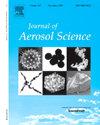Use of electric field to enhance collection of ultrafine particles using quartz crystal microbalance
IF 3.9
3区 环境科学与生态学
Q2 ENGINEERING, CHEMICAL
引用次数: 0
Abstract
In the present study, a Quartz Crystal Microbalance (QCM) technique was used in conjunction with an electric field to measure particle mass concentration of ultrafine particles (UFPs). Using Sauerbrey's equation, particle mass concentration can be estimated from the QCM frequency change. An electric field enhanced particle collection efficiency on the QCM surface, focusing on particle sizes ranging from 30 to 300 nm in aerodynamic diameter. Polydisperse NaCl was used to investigate the relationship between particle mass concentration and two key parameters - collection efficiency and mass sensitivity. Data were obtained using the Scanning Mobility Particle Sizer (SMPS). Particle concentrations were varied from 23.3 to 522.8 μg/m³ for applied voltages from 0 to 1 kV at 5 L/min flow. The optimal condition was achieved at 1 kV at a concentration of 23.3 μg/m³, where total collection efficiencies were between 90.3 and 99.5%. The mass accumulated on the QCM surface was linear with the frequency shift measured by a QCM detector, yielding the mass sensitivity of 0.177 μg/Hz. Based on the minimum frequency shift and general concentration of atmospheric UFPs, the QCM detector is appropriate for hourly measurement. This was confirmed by a good agreement between the predicted particle mass deposition by the mass sensitivity of the QCM and the measured one with a linear fit ( = 0.997).
求助全文
约1分钟内获得全文
求助全文
来源期刊

Journal of Aerosol Science
环境科学-工程:化工
CiteScore
8.80
自引率
8.90%
发文量
127
审稿时长
35 days
期刊介绍:
Founded in 1970, the Journal of Aerosol Science considers itself the prime vehicle for the publication of original work as well as reviews related to fundamental and applied aerosol research, as well as aerosol instrumentation. Its content is directed at scientists working in engineering disciplines, as well as physics, chemistry, and environmental sciences.
The editors welcome submissions of papers describing recent experimental, numerical, and theoretical research related to the following topics:
1. Fundamental Aerosol Science.
2. Applied Aerosol Science.
3. Instrumentation & Measurement Methods.
 求助内容:
求助内容: 应助结果提醒方式:
应助结果提醒方式:


